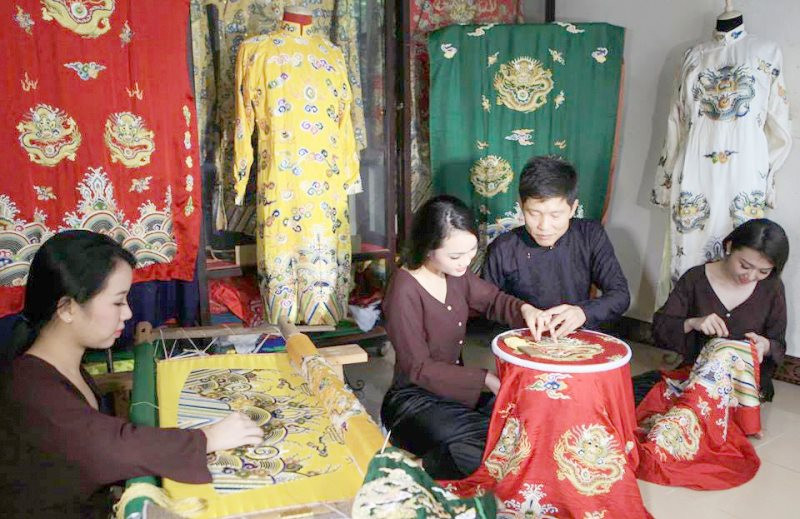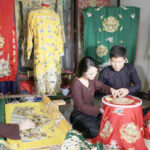Thang Long – Dong Do – Hanoi, throughout its extensive historical journey, has not only been the political, economic, cultural, and social epicenter of the nation but has also been renowned as the “land of a hundred crafts” with its distinctive and unique features. The existence of craft villages holds significance not only economically but also plays a crucial role in preserving, conserving, and promoting the values of traditional cultural heritage.
However, modern life is posing numerous challenges to many craft villages in Hanoi, especially those rooted in traditional craftsmanship, placing them at risk of fading away. The question of how to preserve and develop these traditional craft villages, maintaining the cultural essence that has flowed for thousands of years, demands answers. Hanoimoi Newspaper is honored to present to its readers a series of articles titled “Inheriting the Tradition of the Land of a Hundred Crafts.”

Embroidering the king’s outfits in the Dong Cuu Traditional Craft Village (Dung Tien Commune, Thuong Tin District).
Article 1: The Essence of Traditional Craft Villages
Hanoi currently boasts 806 villages associated with various crafts, of which 321 have earned recognition as traditional craft villages. These craft villages in Hanoi encompass a diverse range of skills: lacquer painting, ceramics, gold and silver crafting, lace embroidery, bamboo and rattan weaving, textile production, papermaking, folk painting, woodworking, stone carving, flower cultivation, bonsai tree care, and more. Many of these villages, with lifespans spanning hundreds or even thousands of years, not only contribute to the economic well-being of their residents but also serve as repositories and creators of cultural and artistic values, embodying the unique characteristics of this historically rich capital.
Heritage Crafts
Bat Trang makes ceramics/Kieu Ky makes gold gilding” – Heading northeast from Hanoi, in the crossroads of Thang Long and Kinh Bac cultures, lies the region adorned with numerous distinctive craft villages. Among them is the traditional gold and silver gilding village of Kieu Ky, in Kieu Ky Commune, Gia Lam District, which has held its illustrious reputation since ancient times.
According to the Party Secretary of Kieu Ky Hamlet, Nguyen Xuan Dung, the craft was passed down by the craft’s forefather, Nguyen Quy Tri, to the residents over 300 years ago, and it has been preserved, transmitted, and cherished ever since. In feudal times, the gold and silver crafting trade in the village flourished, providing gold and silver adornments for religious ceremonies, royal courts, architectural structures, and cultural works. Over centuries, the affluent lives of Kieu Ky residents were shaped by the skilled hands and artistic vision, as well as the persistence, diligence, and meticulousness of gold and silver artisans, who undertook numerous intricate processes.
Today, many stages of gold and silver gilding involve modern machinery, but certain steps remain reliant on the skillful hands and artistic minds of artisans, who carefully bring forth intricate patterns.
According to the meritorious artisan Le Ba Chung from the craft village of Kieu Ky, a skilled artisan can beat a thin sheet of gold covering an area larger than 1m². To achieve this, the gold-gilding artisan must continuously hammer for over an hour with more than 400 strikes of the hammer. Due to its unparalleled uniqueness, some stages of other traditional craft villages, such as sculpture, engraving horizontal lacquered boards, and composing couplets, still seek Kieu Ky to purchase gold leaf for their products. The gold and silver artisans, with their hands and creative minds, contribute to the creation of items, artworks, and architectural features for revered and sacred cultural and artistic structures. With its distinctive and unique traditions, Kieu Ky has been recognized by the state as a national intangible cultural heritage.
Equally remarkable and no less unique is the village of Dong Cuu in Dung Tien commune (Thuong Tin district), preserving the embroidery of the king’s outfits, handed down since the 18th century. The craft guild was founded by Mr. Le Cong Hanh, a royal mandarin from Quat Dong commune (Thuong Tin district), who introduced the art of embroidery to the local people. During the Nguyen dynasty, Dong Cuu embroiderers specialized in crafting royal garments, and ancient patterns, and restoring dragon robes for court officials, nobility, and monarchs. Embroidering the king’s outfits demands meticulous, focused, and skillful artisans following strict standards and possessing cultural and historical knowledge. Some outfits take several years to complete.
People’s artisan Vu Van Gioi from the craft village of Dong Cuu shares that the embroidery technique of Dong Cuu has distinctive features not found everywhere. The unique language of traditional embroidery is embodied in the images of dragons and phoenixes, swirling cloud patterns, and gracefully bending flowers and leaves. Today, the embroiderers in the village produce traditional costumes for cultural preservation, filmmaking, and the creation of couplets, banners, ceremonial robes, and festival attire. Each product tells a cultural story, intertwined with the historical roots of this venerable land, and contributes to the overall cultural heritage of the nation. The traditional embroidery craft of Dong Cuu has been officially recognized as a national intangible cultural heritage.
Traditional Cuisine
The uniqueness and distinctiveness of traditional craft villages also manifest in the refined, intricate, and elegant culinary culture amid modernity, preserving a taste of the past that is unparalleled. Visiting Uoc Le (Thanh Oai district), the sausage-making craft village along the peaceful Day River, one encounters cultural imprints and a rich historical essence: ancient banyan trees, waterfront piers, and communal courtyards. It’s no coincidence that the Uoc Le sausage-making craft village is renowned far and wide, becoming a specialty that leaves an indelible mark on anyone fortunate enough to savor its delights.
Enthusiastically sharing the story of the sausage-making craft, artisan Nguyen Duc Hanh remarks, “The people of Uoc Le have preserved the secrets of hand-mincing meat to achieve a uniquely sticky texture that doesn’t stick to the pestle.” However, relying solely on manual methods would limit the income from the craft. To sustain the craft, in addition to the traditional secrets passed down, the people of Uoc Le have introduced machinery, techniques, and modern technology into production. Despite this, the product’s flavor remains distinctive, with an ever-expanding variety. Currently, beyond meeting local demand, Uoc Le boasts over 200 households spreading the culinary essence of the village across the country and even abroad. Many Uoc Le residents have moved to live in France, the United States, and other countries but continue to maintain the tradition, embodying the distinctive flavor of their homeland’s specialty.
The culinary essence of the rural village near Hanoi is also a connection to the traditional cultural space. Just about 40km from the center of Hanoi, rediscovering the cultural heritage of the Doai region, the craft village of Thach Xa (Thach That district) retains the beauty of traditional rural areas, featuring the ancient Tay Phuong pagoda and serene pathways. The craft of making “che lam” cakes in Thach Xa has been passed down through generations and has weathered its fair share of ups and downs. In recent years, the art of making “che lam” cakes in Thach Xa has experienced a revival, thriving and developing vigorously.
Culture-Social Civil Servant in Thach Xa Commune, Khuong Xuan Hue, revealed that “che lam” cakes are crafted from pure agricultural ingredients such as glutinous rice flour, ginger, peanuts, brown sugar, and malt. To attain distinct flavors, the selection of ingredients holds paramount significance. The glutinous rice for “che lam” cakes must be the fragrant yellow blossom variety, while the ginger must be aged and the peanuts firm and plump. The delectability of lam tea hinges on the recipe as well as the skill and discernment of the bakers’ hands and eyes. Connoisseurs of “che lam” cakes will detect the aroma of freshly milled glutinous rice, the mild sweetness of malt sugar, and a hint of warm spiciness from the ginger. Thanks to its unique flavor, intertwined with the culinary culture of the rural village, despite the myriad of confectionery options, Thach Xa’s “che lam” cakes still secure a place in the market, with the craft village supplying up to 200 tons of “che lam” cakes annually.
There are numerous other dishes and exquisite products from Hanoi’s craft villages that are beyond enumeration. Each craft village product has a unique characteristic, a distinct culinary flavor that not only contributes to improving the lives of the people but also embodies the unique cultural values of the thousand-year-old capital.
Chairman of the Hanoi Artisans Association, Vu Manh Hai, mentioned that many traditional craft villages in Hanoi boast histories spanning thousands of years, tightly connected to and conveying a long chain of the city’s formation and development. Numerous traditional craft village products are still present in distinctive cultural and architectural works, containing unique culinary cultural traits passed down through generations, earning high regard both domestically and internationally. Beyond just embodying the traditional cultural identity of the ethnic groups, many traditional handicraft products in Hanoi also crystallize the essence of their times and encapsulate the talent, intellect, and creativity of the artisans – the pivotal force for preserving and developing these crafts.
According to Mr. Vu Manh Hai, Hanoi currently has numerous mechanisms and policies for developing traditional craft villages, including the recognition of titles for craft villages and artisans. Recognized traditional craft villages make substantial contributions to socio-economic development, especially in preserving, connecting, and disseminating culture. The more society progresses, the more attention and emphasis are required for the preservation and valorization of traditional craft villages.
Reporter Group
Giữ lửa đất trăm nghề (hanoimoi.vn)

